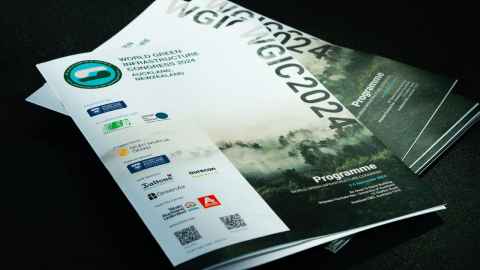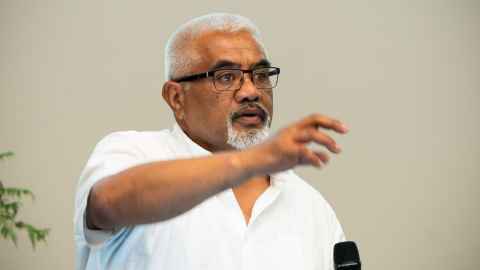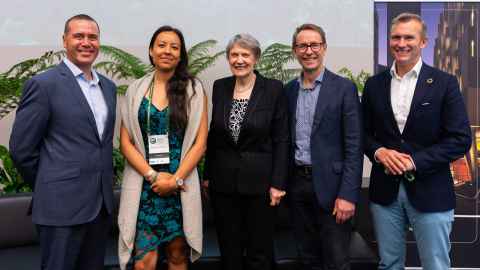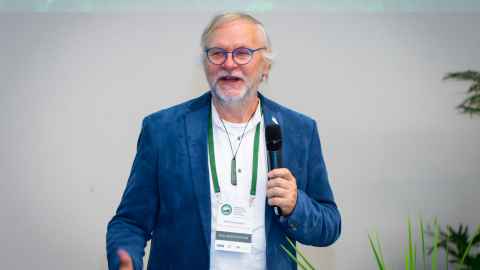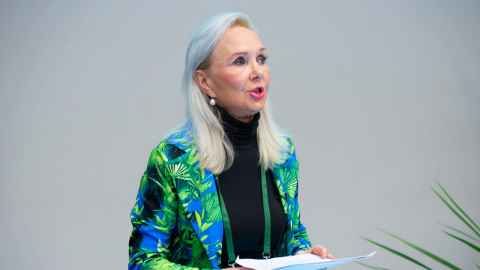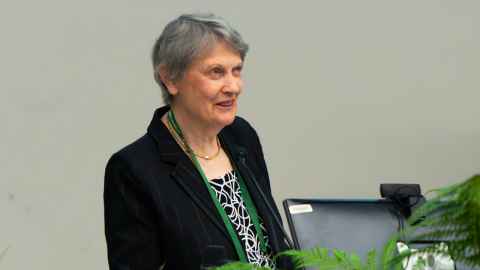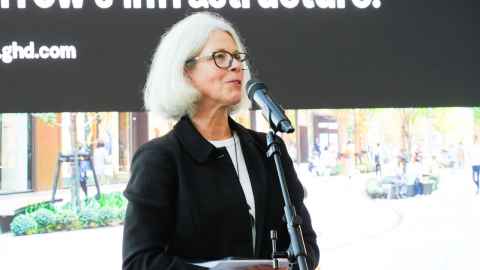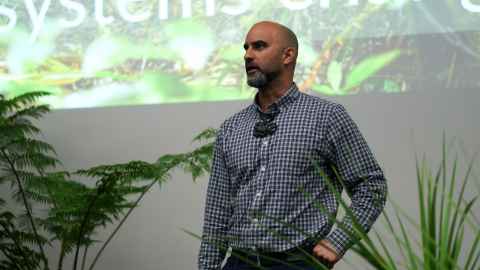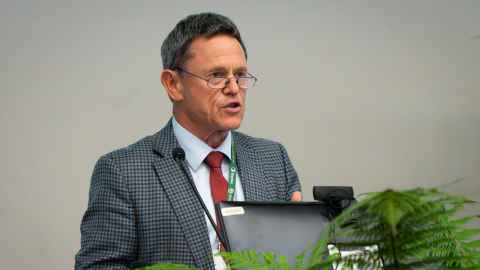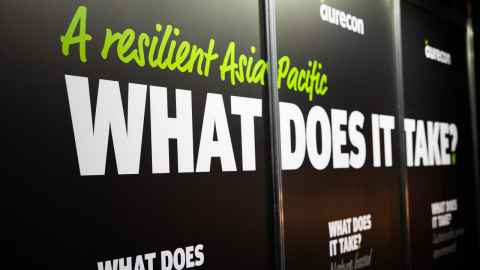Ideas and connections forged at World Green Infrastructure Congress
10 September 2024
The World Green Infrastructure Congress held at the University from 3-5 September saw ideas shared and connections made, to go forth and shape a more sustainable future for urban environments.

“Go greener, faster” was the call to action from Desley Simpson, Deputy Mayor of Auckland, at the 2024 World Green Infrastructure Congress, held at the University of Auckland from 3-5 September and hosted by the Faculty of Creative Arts and Industries.
The deputy mayor introduced the congress and highlighted Auckland’s recent experiences of extreme weather and flooding.
Simpson acknowledged the immense challenges posed in New Zealand by climate change, notably the significant damage to infrastructure last year.
“The magnitude and relentlessness that we experienced in 2023 has taught us some hard lessons and those multiple weather events were a huge wake-up call. We now know that some of our infrastructure planning is based on old weather patterns and is no longer fit for purpose. We've also learned that water needs not just a place to rest, but a space to move around our city.”
Simpson said Auckland's response to the events, including the integration of green infrastructure in urban planning to manage stormwater, reduce flooding and enhance urban spaces, was a step in the right direction.
She praised initiatives such as rain gardens, permeable pavements and tree planting, which aim to protect Auckland’s environment while improving public spaces. The success of projects like the revitalisation of Oakley Creek Park was underscored, demonstrating how green infrastructure restores natural habitats and reduces flood risks. Simpson also pointed to the council's shoreline adaptation plans to combat coastal erosion and rising sea levels, emphasising the need for collaborative efforts from residents, businesses and policymakers.
“It's crucial that we balance development with environmental stewardship … so Auckland becomes resilient and a place where people and nature thrive together, leveraging green infrastructure to meet future challenges.”
We now know that some of our infrastructure planning is based on old weather patterns and is no longer fit for purpose.
Loss of green spaces
Simon Upton, the Parliamentary Commissioner for the Environment in New Zealand, shared key insights from his work on the environmental impact of urban development, focusing on the loss of green spaces in cities. Upton’s role as an independent adviser to Parliament allows him to tackle environmental issues and offer policy recommendations that aren't influenced by the government. His speech emphasised the importance of recognising green spaces and the underlying soil as essential urban infrastructure, equivalent in importance to roads and water systems.
Upton opened his address by reflecting on the significant loss of urban green spaces in New Zealand, sparked by his observation of a development he drove past each day.
“I watched it progress and wondered what life in this future suburb would be like for its residents, when at the very start, it has been stripped of everything green and also any slope had been levelled. The trees, bushes, grass, supporting soil, all-natural elements that could provide essential biophysical services like temperature and stormwater regulation, air filtration, carbon sequestration, were all gone.”
He noted that developments across the country, particularly in Auckland and Hamilton, often involve stripping the land of trees, grass, and natural elements that provide essential services like temperature regulation, air filtration, and stormwater management. “Are we building harder, hotter cities?” he asked, reflecting his paper of the same name. “The answer is yes, we are.”
In his reports, Are We Building Harder, Hotter Cities? and Urban Ground Truths, Upton outlined the growing risks posed by shrinking green spaces. He commissioned research by Manaaki Whenua Landcare Research to study urban green spaces using machine learning and aerial photographs. The findings revealed that while New Zealand's cities still have significant green spaces, these areas have been diminishing, particularly on private land due to infill development and the increasing footprint of new housing.
One of Upton’s key recommendations was the need for standardised monitoring of green space in New Zealand. He said without consistent data on how green spaces are changing, it is impossible to assess the effectiveness of policy measures.
“We are as a country absolutely allergic to gathering data,” he said, stressing the importance of data-driven decision-making in preserving and expanding urban greenery.
He also called for legal reforms, suggesting that urban green spaces should be prioritised in law, on par with traditional infrastructure. Currently, green spaces are considered optional rather than essential, a disparity Upton believes needs to change. He also advocated for incentives to encourage developers to retain existing green spaces and trees, potentially by lowering financial contributions for those who preserve nature in their developments.
Regarding private land, Upton pointed out that tree protection rules are inadequate, with many significant trees being removed without proper oversight. He argued that both public and private landowners need to be part of the solution, especially as most urban land is privately owned.
“Lawns and gardens, once sealed over or built on, are just about impossible to get back,” he warned.
One thing that troubles me is the language of crisis; that we're in a housing crisis, so therefore you can dispense with any sorts of environmental standards or social benefits.
Lazy subdivisions
Another speaker, Rob Stokes, Chair of Net Zero Australia, warned of throwing out environmental standards in response to the need for housing, and creating “lazy subdivisions”.
“One thing that troubles me is the language of crisis; that we're in a housing crisis, so therefore you can dispense with any sorts of environmental standards or social benefits. We can't be lazy with land anymore. We need to be more conscious about how we use it.”
Author, scholar and activist Julia Watson, an Australian working in the US, introduced her concept of Lo-TEK, which stands for “local traditional ecological knowledge”, presenting ancestral, sustainable technologies to address modern environmental crises.
Watson emphasised the significance of Indigenous knowledge systems and technologies, which have allowed communities to thrive for thousands of years by harmonising with nature. She contrasted this with Western approaches that often prioritise extraction and resource consumption over sustainable, cyclical interactions with the environment.
Watson outlined five key principles of Lo-TEK: living, co-evolutionary, co-energetic, symbiotic, and cyclical, illustrating each with case studies from various Indigenous cultures. She recounted how Indigenous communities around the world have developed sophisticated technologies to manage water, biodiversity, and ecosystems in ways that are sustainable and resilient, often in response to extreme climate conditions. Examples include ancient fish traps in Australia, kelp farms on the US East Coast and living root bridges in India, all of which demonstrate deep integration with their environments.
Watson also highlighted the marginalisation of these technologies in modern infrastructure development, attributing it to the dominance of Western science and engineering, which tends to overlook or commodify nature. She advocated for the inclusion of ancestral technologies in contemporary design education, stressing the need to institutionalise Indigenous ecological knowledge.
“If any technology is needed in this climate crisis, it is the ancestral infrastructure that coevolved with communities for tens of thousands of years.”
In a panel discussion led by former PM Helen Clark, visiting US speaker, human ecologist Dr Lyla June Johnston (Diné/Navajo, Tsétsêhéstâhese/Cheyenne), said it was important not just to think of green spaces in cities as being good for people, but to consider ways in which humans can service Mother Nature.
“How can we design ourselves and our systems to be regenerative and nourishing to her systems?”
She also said over the years there has been a romantic Eurocentric adoration of parks, "which is understandable because they’re beautiful".
“But green spaces shouldn’t only be considered for their greenery and their ability to sequester carbon. We should also increase their edibility. So, I’d encourage the edibility aspect along with the landscape aspect.”
How can we design ourselves and our systems to be regenerative and nourishing to Mother Nature?
Green infrastructure and public health
Sir Ashley Bloomfield, a professor in the School of Public Health at the University, said that climate change and urbanisation create significant public health risks and explored the nexus between green infrastructure and public health. He gave an example of the Khoo Teck Puat Hospital in Singapore as an example of a place that promotes healing through nature.
“If you can do it in Singapore, which is a densely populated place, you should be able to do this anywhere. This hospital was designed with the specific intent of lowering patients’ blood pressure as they enter the hospital grounds. This is not just a pipe dream. We know that reducing stress and having a relaxing environment has physical benefits.”
More broadly, Sir Ashley said climate change and urbanisation create significant public health risks, leading to obesity and the transmission of communicable diseases. “But improving infrastructure has the potential to protect and improve public health and help create healthier, fairer, more equitable and resilient communities. The one that's the strongest and best described is the increase in opportunity for physical activity in green neighbourhoods.”
However, he said research is key.
“What we need is to bring people together, and to convene research. Researchers, public health professionals, environmental scientists and end users, including policymakers need to be involved in decision making.
“Our future is one where cities maximise the benefits of urbanisation and mitigate the adverse effect of climate change. Most importantly, and you would do this whether climate is changing or not, we need to create cities that allow fairness to thrive.”
Media enquiries
Email: mediateam@auckland.ac.nz


